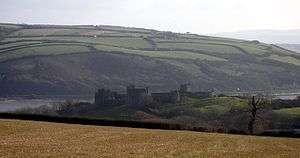Llansteffan Castle
Coordinates: 51°45′56″N 4°23′26″W / 51.765637°N 4.390566°W




%2C_Wales-LCCN2001703522.tif.jpg)
Llansteffan Castle (Welsh: Castell Llansteffan) is a castle overlooking the River Tywi as it enters Carmarthen Bay near the village of Llansteffan in Carmarthenshire, Wales.
Prehistoric site
The castle sits on a much older Iron Age promontory fort, proving Llansteffan has been inhabited for several millennia.[1] The hill's summit can only be reached from one side, and the hill where the castle/fort stands commands the entrance to the River Towy (unlike today, the hill would have been stripped of trees to make foot soldiers vulnerable to attack by archers). The original earthworks can still be seen and were used as part of the modern castle's defence system—the castle proper rests within the earthwork rings.
Norman period and after
The castle was built by the Normans after 1100 as part of their invasion of Wales and granted to the Marmion family before passing to the de Camvilles through marriage.[2][3]
It was captured by Maredudd ap Gruffydd in 1146[4] against the forces of Maurice FitzGerald, Lord of Lanstephan and his brother William FitzGerald, Lord of Emlyn who were the leading Norman settlers of the region. The castle was retaken by the Normans in 1158.[4] Llywelyn the Great recaptured the castle for the Welsh in 1215 and taken back by the de Camville family sometime after 1223. The castle fell to Llywelyn ap Gruffudd in 1257 but returned to the de Camvilles by the 1260s.[4]
By 1367 it was described as in a poor state.[4] The castle is now in the care of Cadw.[5]
Owain Glyndŵr
The castle was captured twice by the forces of Owain Glyndŵr in 1403 and c.1405.[4] It was taken back by Englishman Sir John Pennes, who was back in charge of the castle by 1408.
The castle was later granted to the Crown and the two-tower Gatehouse was converted into a residence.[4]
It is rumoured that a secret passage leads from the castle to the nearby Plas Mansion.
The site is near the Well of St. David and Plas Llanstephan.
See also
References
- ↑ Guilbert and Schweiso, G C and J J (1972). "Llanstephan Castle. An interim discussion of the 1971 excavation". The Carmarthenshire Antiquity. 8: 75–90.
- ↑ George Edward Cokayne (1893), Complete Peerage (hardback), London: George Bell & Sons.
- ↑ Charles Ferrers R. Palmer (1875), History of the Baronial Family of Marmion, Lords of the Castle of Tamworth, etc. (hardback), Tamworth: J. Thompson
- 1 2 3 4 5 6 Lloyd, Thomas; Orbach, Julian; Scourfield, Robert (2006). Carmarthenshire and Ceredigion. London: Yale University Press. pp. 331–332. ISBN 0-300-10179-1.
- ↑ "Llansteffan Castle". Days Out. Cadw. Retrieved 29 Aug 2012.
| Wikimedia Commons has media related to Llansteffan Castle. |